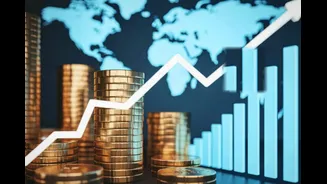There’s something quietly electric about the numbers coming out of India right now. For months, analysts expected the economy to slow a little, maybe hover near 6 per cent growth, weighed down by inflation,
patchy exports and cautious global sentiment.
Instead, India surged ahead, clocking an unexpected 7.8 per cent growth in the first quarter of the 2025–26 financial year, the fastest in five quarters.
That single figure has rewritten forecasts across the board. Economists now predict the country will grow around 6.7 per cent this fiscal year, higher than most advanced economies and firmly cementing India’s place as the fastest-growing major economy in the world. But behind the applause lies a bigger question: what exactly is driving this sprint, and can it last?
A Data Story That Defied Forecasts
The surprise wasn’t just the speed of growth but its timing. Most forecasts had assumed that global headwinds, including slowing exports and volatile crude prices, would weigh down India’s recovery.
Yet domestic data started telling a different story. Private consumption, the beating heart of India’s economy – didn’t just hold steady, it strengthened. Rural demand, long seen as fragile post-pandemic, outpaced urban spending for six consecutive quarters.
Infrastructure spending has also played a starring role. Government-led capital expenditure programs have spurred growth across roads, railways, power grids and ports.
This public push has become the scaffolding for broader economic revival, even as private investment has lagged. Together, consumption and public investment have done what few expected, keep India’s engine roaring while much of the world slowed.
At the same time, reforms introduced years ago have begun to show their compounding effect. The Goods and Services Tax is maturing into a predictable, integrated tax regime.
Digital infrastructure, led by UPI payments and Aadhaar identity systems, has pulled millions into the formal economy. When economists talk about India’s “structural tailwinds,” this is what they mean, the invisible architecture that keeps the machine humming even when global winds blow rough.
The Pillars of the Surge
There are four major forces behind this surprising upswing.
First, domestic demand has stayed remarkably robust. India’s middle class, now estimated to exceed 400 million, is expanding both in size and confidence. Their appetite for spending, whether on consumer goods, personal mobility, or home improvements — has kept industries alive and active.
Second, policy timing has been unusually sharp. The government’s decision to maintain infrastructure spending, introduce targeted tax relief and simplify compliance under GST has fed into household budgets at the right moment. The Reserve Bank of India, too, has played its part, carefully balancing inflation control with enough liquidity to keep credit flowing.
Third, the demographic dividend continues to unfold. Every year, nearly 12 million young Indians join the workforce. This rising working-age population not only boosts productivity but also feeds the consumption cycle. More earners mean more spenders, and that spiral of income and aspiration is visible in everything from smartphone sales to retail credit growth.
Finally, the digital transformation of India’s economy has given it a structural advantage that wasn’t as visible even five years ago. UPI transactions, small-business digitisation and tax data integration have expanded the formal economic footprint, bringing transparency and tax buoyancy. These long-term reforms are slowly translating into sustained, measurable growth.
Why Economists Didn’t See It Coming
If the fundamentals were strong, why did analysts misjudge the pace? Partly because old forecasting models still lean heavily on export data, which has been weak. The assumption was that India couldn’t grow fast without a strong external sector. Yet this time, domestic demand carried the weight.
Another factor was timing. Policy reforms often take years to show results, and economists had underestimated how quickly GST efficiency, digital inclusion and infrastructure projects would begin to feed back into real growth numbers.
Finally, there’s a shift in data dynamics. India’s real-time indicators, from GST receipts and bank credit to power consumption and PMI now offer a more accurate pulse of the economy. When those numbers started flashing green, it became clear that the recovery was not a blip but a trend.
The Risks Under the Hood
Still, no story of growth is complete without its shadows. The first concern is private investment. While consumption is buoyant, corporate investment has been hesitant. Big companies are sitting on healthy balance sheets, but many are waiting for clearer global signals before committing to large-scale expansion. Unless private capex revives, job creation could remain patchy.
External risks loom large too. New U.S. tariffs on Indian exports threaten competitiveness in sectors like textiles, electronics and metals. Sluggish global growth could dampen demand for Indian goods, limiting export potential just as domestic consumption begins to level off.
Inflation is another watchpoint. Although retail inflation has eased, volatility in global commodity prices especially crude oil, could keep the Reserve Bank cautious. If rate cuts are delayed, credit conditions may stay tight, slowing the flow of investment and spending.
And then there’s the sustainability question. Some economists argue that the current growth surge may partly reflect statistical effects — low base numbers and front-loaded consumption before the festive season. Whether this pace can be maintained across the next four quarters will be the real test.
Where Growth Is Showing Up
The most visible beneficiaries of this growth spurt are India’s urban centres. In Bengaluru, Hyderabad, and Mumbai, the service sector is booming again.
IT, financial services, logistics and e-commerce are leading the charge. The service economy has grown over 9 per cent in recent quarters, while manufacturing holds steady near 6 per cent.
But perhaps the quieter story is unfolding in India’s smaller towns. Tier-2 and tier-3 cities are driving new waves of consumption. Local entrepreneurs, backed by digital payments and microcredit, are scaling up faster than before. The informal-to-formal transition is no longer limited to metros, it’s becoming a nationwide current.
Lifestyle shifts mirror these changes. Rising incomes are altering the consumption basket. Indians are spending more on wellness, dining, gadgets, and education. The aspiration curve has moved from owning to upgrading.
Even the Rs 50 office lunch has turned health-conscious – high-protein bowls, millet meals, vegan options. Growth isn’t just an economic statistic anymore; it’s visible in the daily habits of a rising middle class.
The Indicators to Watch
To gauge whether this sprint will sustain, a few markers will matter most:
– GST revenue and direct tax growth, which reflect the depth of demand.
– Bank credit and new investment announcements, showing business confidence.
– Purchasing Managers’ Index, power demand and auto sales, offering real-time clues about production and consumption.
– Trade data and inflation trends, which reveal how global pressures spill into domestic conditions.
If these metrics stay on course, India’s 6.7 per cent growth could easily tip closer to 7.
The Real Test Ahead
India’s growth story today is like a train accelerating on freshly laid tracks — smooth, but still gathering full steam. The question isn’t whether India can sprint; it’s whether it can keep running without overheating or tripping on its own gaps.
The country’s potential is undeniable. A young population, expanding infrastructure, digital efficiency and rising household incomes form a potent mix. But the next phase must focus on jobs, innovation and balanced growth across states. A 6.7 per cent GDP rise means little if millions of young Indians don’t find matching opportunities.
Growth, to truly matter, has to feel personal — in pay cheques, purchasing power, and progress.
India’s surprise this year is that it managed to grow faster than even its optimists expected. The challenge now is to turn that surprise into a habit — a rhythm of resilience that keeps the nation not just sprinting, but striding confidently into its next decade.















